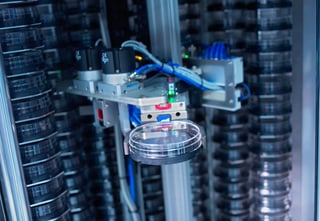blog
September 25, 2017 | Source: Rapid Micro Biosystems, Inc.
Automating and accelerating environmental monitoring in pharmaceutical manufacturing
POSTED BY Rapid Micro Biosystems | 3 minute read
September 25, 2017 | Source: Rapid Micro Biosystems, Inc.
POSTED BY Rapid Micro Biosystems | 3 minute read
Regulations mandate monitoring of room surfaces, air, and personnel throughout pharmaceutical manufacturing.

Automating environmental monitoring can deliver tangible benefits by reducing the time to results and supporting significantly higher volumes. With increased volumes and accelerated results, manufacturers can bring their products to market faster.
Advancing a culture over a century old
Environmental monitoring requires handling and tracking large numbers of samples. The more samples, the greater the risk of error, leading to time-consuming, costly investigations.
The culture-based test commonly used in microbial quality control is more than 100 years old and has drawbacks: Testing is manual and requires growth of micro-colonies over time, which can take up to 7 days.
Automation can maximize process efficiency by eliminating steps once samples are collected, such as labeling them, organizing paperwork, plus retrieving, moving, and counting plates.
For manufacturers with a laboratory information management system (LIMS), automation simplifies steps in sample tracking and results reporting. Even without a LIMS, automated rapid detection technology can deliver the benefits of detection, enumeration, and reporting in half the time.
Succeeding in the interim
Automated detection is valuable for interim results too. It analyzes samples for changes at pre-set intervals and alerts users to variations or positives.
The availability of preliminary positive results within hours instead of days gives the QC team the power to quickly and proactively respond to prevent larger problems.
Validating results
Manufacturers evaluating automated technologies must ensure that each has undergone the appropriate performance verification tests and results are transparent.
To ensure the performance of the Growth Direct™ System meets user requirements, verification encompasses both typical USP organisms and site-specific organisms, as well as disinfectants, surfaces, air monitors, and other areas especially critical to manufacturing. The results demonstrate the effectiveness of Growth Direct, and that sample capture, using Growth Cassettes, is the same as the traditional method.
In environmental monitoring, this translates to proof of equivalence of microorganism capture through microbial spike and recovery experiments and in-situ samples. The experiments involve suitable replicate numbers to allow determination of accuracy with the precision recommended by the United States Pharmacopeia and European Pharmacopeia.
Bottom line: Automated environmental monitoring with Growth Direct produces faster results, allowing pharmaceutical manufacturers to get product to market faster.